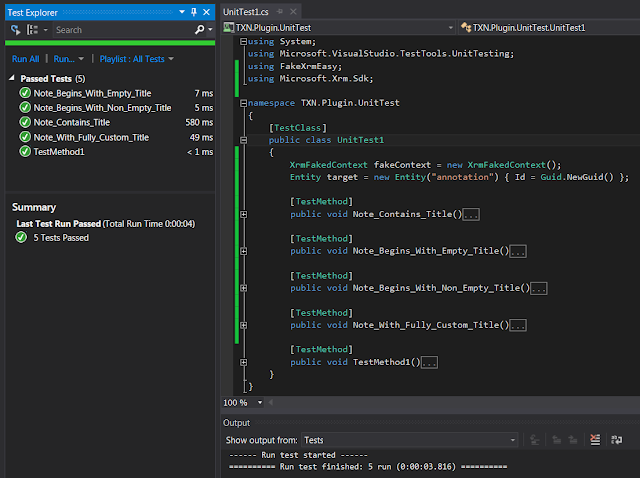Out of the box there's no solution to keep the original source values of ModifiedOn and ModifiedBy when migrating data records to Dynamics 365. In an on-premises deployment you could accomplish the task by the unsupported query update on the destination database; but if you are migrating to cloud Dynamics 365 database access is not an option. In this article I'll walk you through step-by-step guide of one solution proven to work in migration projects. The migration scenario is to move data from an older Dynamics CRM system to online Dynamics 365/CRM; but this could work for other data sources wishing to migrate to Dynamics 365/CRM.
The steps are:
1. Create temporary fields in destination entity to hold the source values of ModifiedOn and ModifiedBy.
2. Write plug-in to set ModifiedOn/By values of destination entity.
3. Register the plug-in.
4. Map source fields to temporary fields and run the migration/import
Step 1: Create 2 temp fields new_ModifiedOn and new_ModifiedBy in the destination environment. Whatever method/tool of migration you will use, the source ModifiedOn will set value for destination new_ModifiedOn; and source ModifiedBy will set value for destination new_ModifiedBy.
Step 2: Write plug-in to set value of destination ModifiedOn and ModifiedBy. Core code for the plug-in is at the end.
Step 3: Register the plug-in, on create message and Pre-Operation.
Step 4: Map the fields for migration/import, like I mentioned in Step 1 - source ModifiedOn to destination new_ModifiedOn, and ModifiedBy to new_ModifiedBy
Now if you run the migration/import, the plug-in will pickup the original values in temp fields and set them for ModifiedOn/ModifiedBy upon creation of new record.
Here is my plugin:
using System;
using Microsoft.Xrm.Sdk;
using Microsoft.Xrm.Sdk.Query;
namespace TXN.Plugin.PreserveRecordInfo
{
public class PreCreateRecord : IPlugin
{
#region Secure/Unsecure Configuration Setup
private string _secureConfig = null;
private string _unsecureConfig = null;
public PreCreateRecord(string unsecureConfig, string secureConfig)
{
_secureConfig = secureConfig;
_unsecureConfig = unsecureConfig;
}
#endregion
public void Execute(IServiceProvider serviceProvider)
{
ITracingService tracer = (ITracingService)serviceProvider.GetService(typeof(ITracingService));
IPluginExecutionContext context = (IPluginExecutionContext)serviceProvider.GetService(typeof(IPluginExecutionContext));
IOrganizationServiceFactory factory = (IOrganizationServiceFactory)serviceProvider.GetService(typeof(IOrganizationServiceFactory));
IOrganizationService service = factory.CreateOrganizationService(context.UserId);
if (context == null) throw new InvalidPluginExecutionException("IPluginExecutionContext is null");
if (service == null) throw new InvalidPluginExecutionException("IOrganizationService is null");
if (tracer == null) throw new InvalidPluginExecutionException("ITracingService is null");
tracer.Trace("TXN: message: " + context.MessageName + " | Timestamp: " + DateTime.Now);
if (context.InputParameters.Contains("Target") && context.InputParameters["Target"] is Entity)
{
Entity entity = (Entity)context.InputParameters["Target"];
string _message = context.MessageName.ToUpper();
string _entityLogical = entity.LogicalName;
tracer.Trace("TXN: entity: " + entity.LogicalName + " | GUID: " + entity.Id.ToString());
//TXN: Filter the message and your entities here
if (!(_message == "CREATE" ) ||
!(_entityLogical == "knowledgearticle" ||
_entityLogical == "adobe_agreement" ||
_entityLogical == "phonecall" ||
_entityLogical == "fax" ||
_entityLogical == "letter" ||
_entityLogical == "appointment" ||
_entityLogical == "email" ||
_entityLogical == "task"))
return;
try
{
DateTime _initDate = new DateTime(2099, 12, 12);
DateTime _modifiedOn = _initDate;
string _modifiedBy = null;
if (entity.Contains("new_modifiedon") && entity.Attributes["new_modifiedon"] != null)
{
_modifiedOn = (DateTime)entity.Attributes["new_modifiedon"];
tracer.Trace("TXN: mapped new_modifiedon: " + _modifiedOn.ToString());
}
if (entity.Contains("new_modifiedbyname") && entity.Attributes["new_modifiedbyname"] != null)
{
_modifiedBy = (entity.Attributes["new_modifiedbyname"]).ToString();
tracer.Trace("TXN: mapped new_modifiedbyname: " + _modifiedBy);
}
//TXN: Set original modifiedon value in destination record
if(!_modifiedOn.Equals(_initDate))
{
entity.Attributes["modifiedon"] = _modifiedOn;
tracer.Trace("TXN: set modifiedon to: " + _modifiedOn.ToString());
}
//TXN: find new_modifiedbyname and set that user to destination record's modifiedby
if (_modifiedBy != null)
{
var fetchXml = @"<fetch version='1.0' output-format='xml-platform' mapping='logical' distinct='false'>
<entity name='systemuser'>
<attribute name='fullname' />
<attribute name='systemuserid' />
<filter type='and'>
<condition attribute='fullname' operator='eq' value='{0}' />
</filter>
</entity>
</fetch>";
fetchXml = string.Format(fetchXml, _modifiedBy);
EntityCollection users = service.RetrieveMultiple(new FetchExpression(fetchXml));
if (users != null && users.Entities.Count > 0)
{
entity.Attributes["modifiedby"] = users.Entities[0].ToEntityReference();
tracer.Trace("TXN: set modifiedby to user: " + users.Entities[0].GetAttributeValue<string>("fullname"));
}
}
}
catch (Exception e)
{
throw new InvalidPluginExecutionException(e.Message);
}
}
}
}
}














